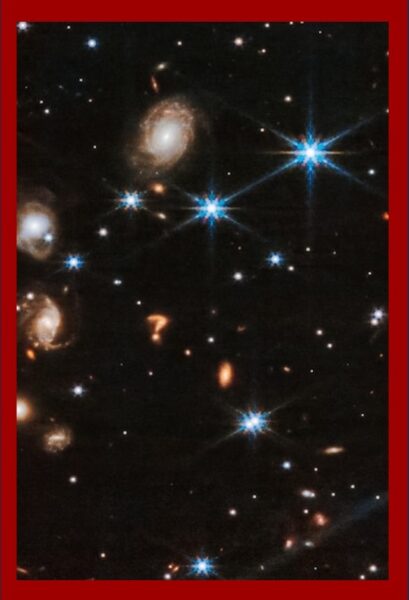Ancient History
“Oh Wow!”
Human beings have gotten cricks in our necks staring at the night sky for a long time. The Lascaux caves in France, dating from 30,000 years ago have a graphical representation of the Pleiades; a carved mammoth ivory tusk carbon dated to 32,500 years ago has what may be the oldest existing star chart.
Astronomers often date the beginnings of their field to the Babylonians in 1000 BCE who produced the first systematic observation records of star and planet movements. This ignores whatever observation and calculations that allowed the megalithic people to build New Grange, the barrow tomb north of Dublin where a single beam of sunlight comes through a window to an altar on the Winter Solstice or Stonehenge oriented to the Summer Solstice. How’d they do that?
Hans Lippershey invented the telescope in the Netherlands in 1608. Galileo appropriated and improved this invention and discovered four moons orbiting Jupiter. Humans kept improving telescopes beyond two lenses and a tube. We made them with ever-larger curved mirrors; we put them on mountain tops. We figured out how to use radio waves and microwaves, infrared, ultraviolet, x-ray, gamma rays to see farther and farther out into the Universe.
In the 1920s Edward Hubble noticed that the Universe was expanding and the Big Bang origin story came into being (George Lemaître 1927).
Bang – Heat – Light – gravity forms stars – gravity sucks stars into galaxies – stars die implode (black holes) -stars suck-in-spin-off planets (like us) -and the Universe keeps expanding and expanding.
“Oh Wow!”
(Then there’s all that quantum level stuff that physicists and astronomers don’t understand – so what hope is there for me? Don’t get me started on the multiverse. Sheesh!)
Telescopes in Space
In 1990 NASA put the Hubble Space Telescope into low Earth orbit designed to avoid atmospheric distortion and all that light pollution from Earth. It was to be maintained by astronauts. Hubble did not disappoint. We got wonderful pictures – Jupiter and Saturn as never before seen, Crab Nebula, Lagoon Nebula, star bursts, spiral galaxies – spectacular on screen and no crick in the neck.
“Oh Wow!”
Before the Hubble was even on the launch pad scientists started asking, “Hey what could we do next?”
“Bigger. We could do bigger?”
“Yeah, and farther out. Maybe three times as far. Maybe orbit the sun instead of Earth?”
“Nah, it’d get burnt by the sun.”
“Maybe stick it behind the Earth in the Legrange L2 point, like Herschel, but with a bigger wave length.”
“Whoa, dude, you are a genius, We’re gonna need some help maybe Europe and Canada.?”
“You are cooking with gas!”
Big projects take some time and the James Webb Space Telescope, a collaboration between NASA, the European Space Agency and the Canadian Space Agency was launched from a site in Africa on Christmas 2021.
In July 2022, the first pictures came back. Scientists did what scientists do. They analyzed, did calculations, tested hypotheses, compared with previous data.
“Hey wait a minute. We can see the Bang and the whole heat before light thing, but it looks like there are galaxies forming before stars? That can’t be right, can it?”
“Wait, What? And what’s that thing over there? It looks like a big question mark in the sky.?
“Oh, Wow!”
Question Mark in the Sky
It is true that the findings from the images sent to Earth from the Webb Space Telescope has caused astronomers to question certain elements of the Big Bang theory about the formation of the Universe. And they haven’t hypothesized a reason why just yet. The are working on it and I’m sure that philosophers and theologians are waiting on pins and needles.
It is also true that one of the pictures showed a big yellow question mark in the sky.
“Wait, what? Dude you can’t just put that picture out there, man.”
“Whoa.. . Right.”
Scientists did what scientists do. They analyzed, did calculations, tested hypotheses, compared with previous data.
They came up with an explanation that sounded like what I said to my father when he observed from the passenger seat that I was going eighty miles per hour.
“Ah . . . no Dad,. . . that’s like the ‘parallax effect.’ It only looks like the speedometer is at eighty because of the angle you’re looking from. I’m really doing sixty-five.” (It didn’t work.)
“It looks like a group or a chance alignment of 2 or 3 galaxies,” Kai Noeske, ESA communication program officer, said over email. “The upper part of the question mark looks like a distorted spiral galaxy, maybe merging with a second galaxy.” Parallax effect.
“Oh, Wow! . . .Right”
An Alternate Explanation
“They are not getting it.”
“Really? Maybe we should just give it some time.”
“I am telling you, they are not getting it.”
This is the overheard thought conversation resonating between gamma rays various wave length radio waves picked up on a big-stick AM radio station in Kearney, Nebraska. It is unclear who the “speakers” are – deities, living beings of some kind, faces of a single deity, or some other personages?
“But that is their mark of existential inquiry”
“Here is what they are saying:
“chance alignment of 2 or 3 galaxies, . . distorted spiral galaxy, maybe merging with a second galaxy… parallax effect “
“Well , , , technically that is true. That is what it is and how we are doing it and frankly it takes a lot of work. Aren’t they asking why?
“No. . . and that’s not surprising. . . that’s the pattern we’ve observed for centuries. Lots of focus on the what and how and very little on the why.”
“But we’ve never done anything this overt before.”
“They are not getting it.”
“Parallax effect? Wow! These are supposed to be the smart ones.”
“Look there’s a big question mark in the sky seen by that billion dollar thingee they shot up. A question mark and they don’t ask why?”
“Look, they are killing each other daily, destroying the only place they have to live. Some are starving, Some are without a roof over there heads, while others have more then they could use in seven lifetimes and they don’t ask why. Why should this be any different?”
“Could we send someone down?”
“Like that has worked so well in the past.”
“Perhaps we should recognize that this experiment isn’t working? Maybe we should start over.”
“It is clear that it isn’t working. That’s why we did the question mark.”
“Maybe the question mark isn’t as clear a message as we think it is.”
“What do you mean?”
“Well. . . I know it’s a lot of work. . . but we could pull in a couple of other galaxies, an imploded star, and a black hole. . . ‘
“A Black Hole? You know how unstable those things are!”
“Yeah I know, but work with me here. Look I sketched it out. We pull these two galaxies here, crush this star in on itself, pull that nebula on its side with this star that’s about to expand. It’ll all come together just here so and their telethingee sees this:

“Do you think they’ll get that?”
“I dunno, but it’s worth a try.”
“We could try dinosaurs again.”
“Probably not. Platypuses would be good for a laugh”
“Roaches?”
“At least they know how to survive.”.
“OK, let try your three-letter idea.”
“One more time.”






WTF probably wouldn’t work either, Alan.
But WTF do I know?
Probably not, Bob
Just a funny guess WTF